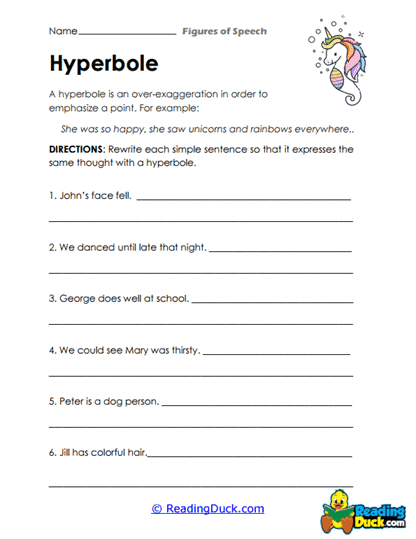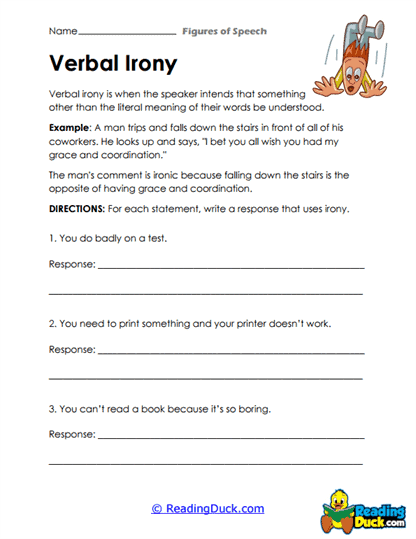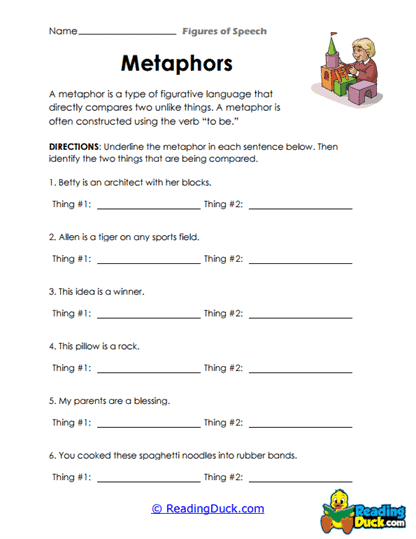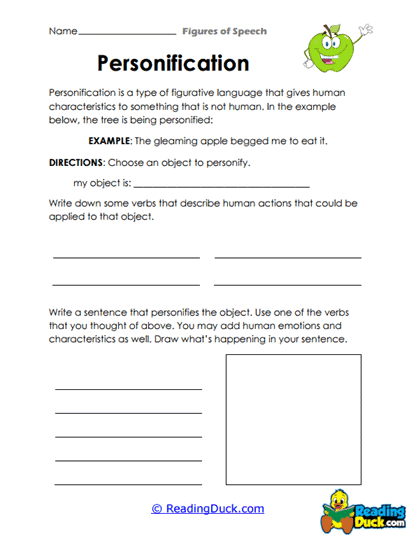Figures of Speech Worksheets
About Our Figures of Speech Worksheets
Our collection of Figures of Speech Worksheets falls within the Language category in the Skills section. This collection is specifically designed to help students understand, identify, and use various figures of speech effectively. Figures of speech are crucial for enhancing language skills, allowing students to enrich their reading comprehension and writing by recognizing and using non-literal language to convey deeper meaning, emphasize ideas, or add creativity to their expression. These worksheets guide students through the nuances of figures of speech in a clear, structured manner, ensuring they gain mastery over this vital aspect of language.
The worksheets are provided in PDF format, making them easy to access, download, and print for both in-class and home learning settings. Additionally, each worksheet includes a downloadable answer key, which simplifies the process of reviewing and assessing students’ understanding of the material.
Exploring Figures of Speech in Language
Figures of speech are rhetorical devices used to add layers of meaning or emphasis to language by going beyond the literal meanings of words. They allow speakers and writers to convey more complex ideas, create imagery, or evoke emotions in a subtle and often poetic way. Understanding figures of speech is essential because it helps students read more deeply into texts and express their ideas in more sophisticated ways.
What Are Figures of Speech?
Figures of speech are stylistic devices that enhance communication by making language more expressive and engaging. These devices rely on non-literal meanings, comparisons, or exaggerations to convey ideas in ways that literal language cannot. Figures of speech serve to add emphasis, create imagery, or convey emotions more vividly.
Some of the most common figures of speech include:
Metaphor: A figure of speech that makes a direct comparison between two unrelated things by stating that one thing is another.
-
- Example: "The classroom was a zoo." This metaphor suggests that the classroom was chaotic without directly saying so.
Simile: A comparison between two things using "like" or "as" to highlight their similarities.
-
- Example: "Her voice was as sweet as honey." This simile compares the pleasantness of her voice to the sweetness of honey.
Personification: This figure of speech gives human traits or characteristics to non-human objects, animals, or abstract concepts.
-
- Example: "The wind whispered through the trees." In this example, the wind is personified, giving it the human ability to whisper.
Hyperbole: Hyperbole is a deliberate exaggeration used for emphasis or humor.
-
- Example: "I’ve told you a thousand times to clean your room!" The exaggeration highlights the frustration in repeating the request.
Alliteration: The repetition of the same initial consonant sound in a sequence of words.
-
- Example: "Peter Piper picked a peck of pickled peppers."
Each of these figures of speech allows for different stylistic effects, enhancing communication by adding depth and richness to language. By mastering them, students improve their ability to interpret complex texts and to express themselves with creativity and precision.
The Many Functions of Figures of Speech
Figures of speech serve various purposes in language, from adding emphasis and clarity to evoking imagery and emotion. They are widely used in literature, daily conversation, advertising, and even public speaking, making them a versatile tool for effective communication. Let’s explore some of the primary uses of figures of speech in different contexts.
Creating Vivid Imagery
One of the primary functions of figures of speech is to create vivid imagery in the minds of readers or listeners. By comparing, personifying, or exaggerating elements of language, figures of speech help paint pictures with words, making abstract or complex ideas more tangible and relatable.
- Example of metaphor: "Life is a journey, with its twists and turns." This metaphor uses the concept of a journey to describe the unpredictability and challenges of life, making it easier for the reader to understand the concept in a visual way.
Enhancing Emotional Impact
Figures of speech also play a key role in evoking emotion. By using metaphors, similes, or personification, writers and speakers can convey feelings that resonate more deeply with the audience. For example, a person might say, "My heart sank," instead of merely stating, "I felt sad," to illustrate the depth of their emotion more powerfully.
- Example of personification: "The flames danced in the fireplace." By giving the flames human-like qualities, this personification adds a sense of warmth and liveliness to the scene, making the description more engaging and emotionally charged.
Adding Emphasis and Humor
Figures of speech such as hyperbole are commonly used to exaggerate for emphasis or humor. In both casual and formal language, hyperbole can stress the importance of a point or make a situation sound more dramatic or humorous than it truly is.
- Example of hyperbole: "I’m so hungry I could eat a horse!" This exaggerated statement is not meant to be taken literally but emphasizes the speaker’s extreme hunger in a humorous way.
Creating Memorable Language
Alliteration and other sound devices are often used to create memorable phrases that are pleasing to the ear. This is why figures of speech are popular in advertising, poetry, and public speaking. The repetition of similar sounds or rhythmic patterns makes the language more engaging and easier to remember.
- Example of alliteration in a speech: "We will rise, rebuild, and recover." The repetition of the "r" sound gives this phrase a rhythmic quality, making it more memorable for the audience.
How Figures of Speech Contribute to Literacy Skills
Mastering figures of speech is a crucial aspect of literacy development. By learning to recognize and use these rhetorical devices, students enhance their reading comprehension, writing skills, and speaking abilities. Figures of speech challenge students to think critically about language and interpret meaning beyond the surface, which is vital for deeper understanding of texts and for more expressive communication.
Strengthening Reading Comprehension
When students can identify figures of speech in a text, they are better equipped to interpret its deeper meaning. Many literary works rely heavily on metaphor, simile, and personification to convey themes, emotions, and complex ideas. Recognizing these devices allows students to engage more fully with the text, appreciating the layers of meaning that might otherwise be missed.
- Example in literature: In Shakespeare’s Romeo and Juliet, the line "Juliet is the sun" is a metaphor that conveys Romeo’s feelings about Juliet in a more powerful way than a literal description would.
By understanding such metaphors, students can better grasp the underlying emotions and themes within the text.
Enhancing Writing Skills
Figures of speech empower students to write with greater creativity, expressiveness, and precision. When students incorporate metaphors, similes, and other devices into their writing, they move beyond basic descriptions and begin to craft more nuanced and engaging narratives or arguments.
- Example in student writing: Instead of writing, "The boy ran fast," a student might write, "The boy ran like the wind," creating a more vivid and imaginative picture for the reader.
By using figurative language, students learn to communicate their ideas in a way that captures the reader’s attention and evokes strong imagery.
Improving Speaking Skills
Figures of speech also enhance verbal communication. By using metaphors, hyperbole, or alliteration in their speeches or everyday conversations, students become more compelling speakers. These devices add color and emphasis to their words, making their communication more impactful and memorable.
- Example in public speaking: A speaker might say, "The road ahead may be rough, but we have the strength to weather the storm," using metaphor to communicate resilience in a more powerful and motivating way.
Creative Activities to Reinforce Learning
Educators can implement various activities to help students better understand and apply figures of speech. These activities encourage creativity and active learning while reinforcing the concepts taught in the worksheets. Suitable for different grade levels, these activities can be used in both school and homeschool settings.
Classroom Activities
- Figure of Speech Sorting Game: In this game, students are given different phrases and must categorize them based on the type of figure of speech they represent (e.g., metaphor, simile, hyperbole). This activity promotes active learning and helps reinforce recognition of different figures of speech.
- Figurative Language Story Challenge: Have students write short stories using at least five figures of speech. This activity encourages creative writing while also helping students apply their knowledge of figurative language in context.
Homeschool Activities
- Metaphor and Simile Hunt: Encourage students to read a short story or poem and highlight any metaphors or similes they find. Afterward, they can discuss the effect these figures of speech have on the meaning of the text.
- Personification in Nature: Have students go on a nature walk and describe what they see using personification. For example, they might say, "The trees waved their branches in the wind." This activity combines learning with real-world observation and creativity.
The Importance of Figures of Speech in Everyday Life
In conclusion, figures of speech are a vital component of language that allow for more creative, expressive, and effective communication. Whether used in literature, speeches, or everyday conversation, these rhetorical devices help convey complex ideas, evoke emotion, and create memorable language. Mastering figures of speech improves students’ literacy skills, enabling them to better interpret the world around them and express their own thoughts and ideas more vividly.
In real-life applications, figures of speech are used in advertising, journalism, literature, and public speaking. Whether crafting a powerful metaphor in an essay or using alliteration in a speech, figures of speech give students the tools to communicate with clarity, creativity, and impact in a wide range of settings.









